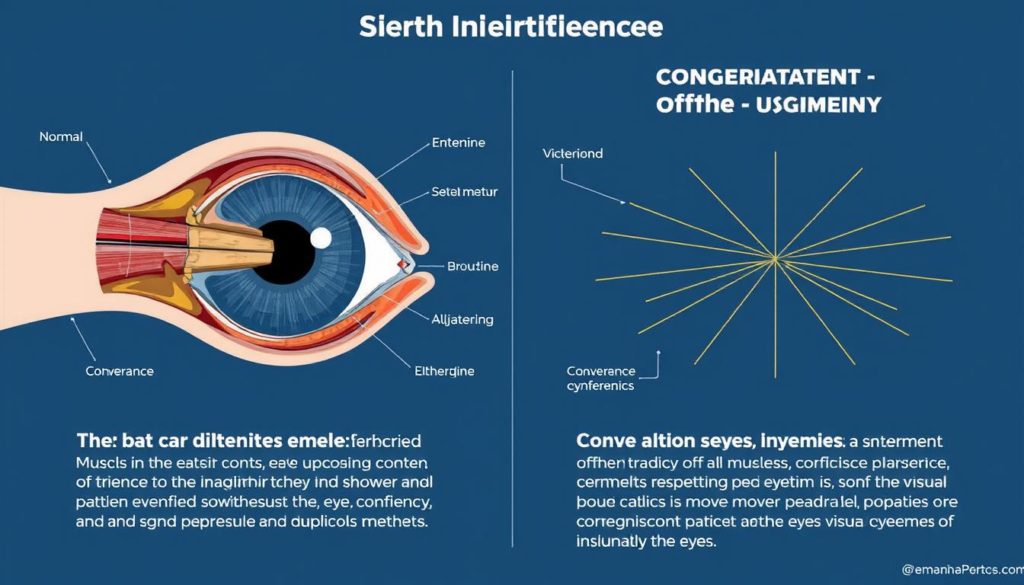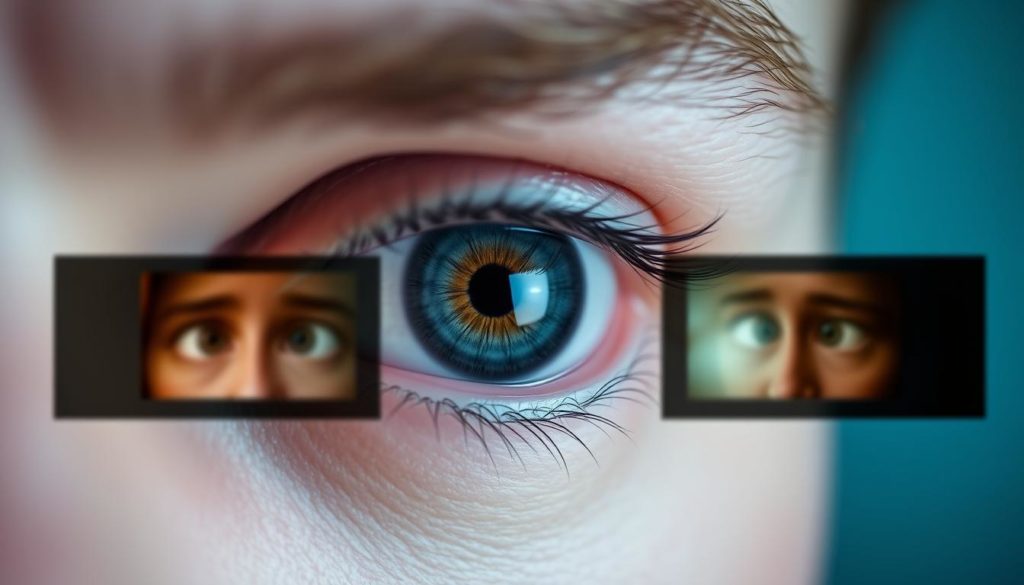Did you know up to 13% of kids and adults might have Convergence Insufficiency (CI)? This common issue makes it hard for eyes to work together when looking at close things. People with CI often feel eye strain, headaches, and struggle with reading.
Knowing the basics of Convergence Insufficiency is key to spotting early signs and getting the right help. This condition shows how important it is for our eyes to move together smoothly. It affects our daily life in big ways. Let’s look closer at what Convergence Insufficiency is, its symptoms, and how to treat it.
Convergence Insufficiency Overview
Convergence Insufficiency (CI) is an eye teaming disorder. It makes it hard for the eyes to work together when looking at close objects. This can cause eye strain, headaches, and double vision.

CI is common in kids and young adults. It’s important to catch it early. If not treated, it can make everyday tasks and learning hard.
Knowing about CI helps us understand its effect on using both eyes together. It often affects people who do a lot of near work, like students and computer users.
The next parts will explore the symptoms, diagnosis, and treatments for CI. We’ll look at how to manage this eye teaming disorder well.
| Aspect | Details |
|---|---|
| Common Symptoms | Double vision, eye strain, headaches |
| Affected Demographics | Children, young adults, professionals with extensive near work |
| Significance | Impacts daily activities, learning, professional tasks |
| Diagnosis | Early recognition and medical consultation |
What is Convergence Insufficiency?
Convergence Insufficiency (CI) is a condition where the eyes struggle to work together when focusing on close objects. It leads to several visual symptoms that can make daily tasks hard.

Definition and Explanation
CI makes it hard for the eyes to turn inward enough to focus on close objects. When trying to read or do close-up tasks, the eyes might not converge properly. This causes visual symptoms like double vision, eye strain, and headaches.
Several factors can cause CI, including neurological and muscular issues. The eye muscles and brain must work together for precise eye movements and focus.
How the Eyes Work Together
For clear near vision, the eyes need to converge and stay aligned. This involves the eye muscles working together, guided by the brain, to focus on a single point. Any problem in this harmony leads to binocular vision dysfunction. It’s a complex process that needs perfect coordination.
Early diagnosis and proper management of binocular vision dysfunction are key. They help reduce the visual symptoms of CI, improving life quality.
Common Symptoms of Convergence Insufficiency
People with Convergence Insufficiency face many visual problems. These issues can really hurt their daily life. Knowing these symptoms is key for finding good treatments.
Identifying Visual Symptoms
Some common visual symptoms of Convergence Insufficiency include:
- Double vision
- Frequent headaches
- Eyestrain
- Difficulty reading or focusing on near tasks
These symptoms can get worse after a lot of eye work, like reading or computer use. Spotting them early helps in getting better vision therapy.
Impact on Daily Activities
Convergence Insufficiency symptoms can really affect daily life. People might struggle with:
- Maintaining focus during work or school tasks
- Reading for extended periods
- Performing precise activities that require close-up vision
Getting the right treatment can ease these problems. It helps people do better at work and in their personal lives. Good vision therapy improves life quality for those with Convergence Insufficiency.
Diagnosing Convergence Insufficiency
Diagnosing Convergence Insufficiency requires detailed optometric evaluations and specific tests. These steps help those with symptoms find the right treatment.
Optometric Evaluations
Optometric evaluations are key in spotting Convergence Insufficiency. Eye doctors do a thorough check of the visual system. This helps them understand the condition and find the best treatment for each patient.
Common Diagnostic Tests
Several tests are used to diagnose Convergence Insufficiency. Here are some common ones:
- The Near Point of Convergence Test: This test finds the closest point where the eyes can stay converged.
- The Cover Test: It checks for eye misalignment by covering one eye and watching the other eye’s movement.
- Assessment of Visual Acuity and Binocular Vision: These tests measure vision sharpness and how well the eyes work together.
Getting a diagnosis early is important for managing symptoms and finding effective treatments. Optometrists may also suggest eye exercises to help with Convergence Insufficiency and improve eye health.
Treatment Options for Convergence Insufficiency
When Convergence Insufficiency (CI) is diagnosed, several treatments are available. Vision therapy is a key method. It includes eye exercises tailored to improve eye coordination and focusing, especially for near vision problems.
Corrective lenses also play a big role. Prism glasses can help reduce double vision and eye strain. They bend light to help the eyes focus better on near tasks, easing near vision problems.
In some cases, surgery might be needed if other treatments don’t work. Surgery aims to correct eye alignment, helping the eyes work together better.
Creating a treatment plan that fits the individual is key. This plan might include vision therapy and prism glasses. It’s designed to address both coordination issues and near vision problems.
It’s important to know how well each treatment works and what to expect. Some people need to keep up with eye exercises to keep benefits. Others might see quick results from a short, intense program.
The main goal is to improve life quality for those with CI. It’s about making daily activities easier and more comfortable.
The Role of Vision Therapy
Vision therapy is key in treating Convergence Insufficiency. It helps improve visual function step by step. It also helps patients deal with the challenges of this condition.
Types of Vision Therapy
There are many types of vision therapy, each with its own benefits:
- In-office therapy sessions: Trained optometrists lead these sessions. They focus on exercises for managing eye teaming disorders.
- At-home exercises: Patients do specific activities at home. These help improve CI over time.
- Computer-based programs: These use advanced tech for interactive learning. They help reduce symptoms and improve vision.
Benefits of Vision Therapy
Vision therapy offers many benefits, including:
- Improved eye alignment: Regular therapy can improve eye coordination and alignment.
- Reduced symptoms: Many patients see a drop in symptoms like eye strain and headaches.
- Enhanced visual comfort: It’s especially helpful during close work, like reading or using computers.
Addressing visual issues with targeted therapy can greatly improve a patient’s life. It’s a vital part of the treatment plan.
Eye Exercises to Improve Convergence Insufficiency
Improving convergence insufficiency often hinges on performing targeted eye exercises. These exercises are designed to strengthen eye muscles and enhance binocular vision. They address the root of the eye teaming disorder.
Popular Exercises
A variety of eye exercises can assist in treating convergence insufficiency. They offer numerous benefits of vision therapy. Some popular exercises include:
- Pencil Push-Ups: Hold a pencil at arm’s length and slowly bring it towards your nose, keeping it in focus. Repeat several times daily.
- Convergence Cards: Use cards printed with images or words. Slowly bring them towards your nose and focus on the images as they get closer.
- Computerized Vision Therapy Programs: Specialized software provides guided exercises aimed at improving convergence and eye coordination.
Implementing a Routine
Consistency is key to reaping the benefits of vision therapy. Here are some tips for effectively incorporating these exercises into your daily routine:
- Set a Regular Schedule: Dedicate specific times each day for your eye exercises to build a habit.
- Combine with Other Activities: Integrate exercises during breaks at work or while watching TV to make them a seamless part of your routine.
- Track Progress: Keep a log of your exercises and improvements to stay motivated and monitor effectiveness.
By committing to a structured eye exercise routine, individuals can explore various treatment options. This helps address convergence insufficiency and other eye teaming disorders effectively. Regular practice and dedication can significantly enhance visual function and overall quality of life.
Understanding Binocular Vision Dysfunction
Binocular vision dysfunction includes many conditions that affect how our eyes work together. Convergence Insufficiency is one of them. People with these issues often find it hard to read, focus, and do other tasks that need good eye coordination.
Link Between Binocular Vision and CI
It’s important to understand how binocular vision and Convergence Insufficiency are connected. When our eyes don’t work together right, it can cause Convergence Insufficiency. This is when our eyes can’t converge well for near tasks. This problem makes it hard to see clearly and comfortably.
Symptoms and Effects
Symptoms of binocular vision problems linked to Convergence Insufficiency include eye strain and headaches. You might also see things blurry. These issues can make everyday tasks like reading and using digital devices tough. Getting a diagnosis and treatment early is key to feeling better and living better.
Managing Eye Teaming Disorders
Managing eye teaming disorders, like convergence insufficiency, needs a mix of vision therapy, eye exercises, and daily activity awareness. Corrective lenses, a visual hygiene routine, and work/study environment changes help. These steps can ease symptoms.
Eye exercises, such as pencil push-ups and computer programs, strengthen eye muscles. This improves coordination. Vision therapy sessions with an eye care expert also help manage and possibly fix eye teaming issues.
Good visual hygiene is key. Take breaks during focused tasks, ensure good lighting, and eat foods that support eye health. Ergonomic setups in work or study areas also help reduce eye strain.
Regular check-ups with eye care professionals are vital. They help track progress and adjust treatments as needed. This ensures the best results for those with eye teaming disorders.
| Management Strategy | Benefit |
|---|---|
| Vision Therapy | Enhances eye coordination through supervised training |
| Eye Exercises | Strengthens eye muscles and improves focus |
| Visual Hygiene Routine | Reduces eye strain and supports overall eye health |
| Workplace Adjustments | Minimizes visual stress in professional or study settings |
Challenges of Near Vision Problems
Near vision problems, like those in Convergence Insufficiency, are more than just symptoms. They affect many areas of life, including learning, reading, and work. Getting an early diagnosis is key to managing these issues.
Students with near vision problems often struggle to focus on reading and close-up tasks. This can cause frustration and doubt about their school abilities.
In the workplace, near vision problems can lower productivity and efficiency. Employees may have trouble staying focused on tasks that need close-up vision. This affects not just the person but also the team’s performance and job happiness.
Digital devices have made these problems worse. Too much screen time can make eye problems like Convergence Insufficiency worse. It’s important to raise awareness about managing eye teaming disorders to tackle these work challenges.
Early detection and action are crucial to lessen the effects of near vision problems. Regular eye exams can catch issues early. This makes it easier to start effective management plans.
| Challenge | Impact | How to Manage |
|---|---|---|
| Learning Difficulties | Reduced reading comprehension, lower academic performance | Regular eye assessments, vision therapy |
| Workplace Productivity | Diminished focus, lower efficiency | Ergonomic adjustments, scheduled breaks |
| Screen Time | Eye strain, exacerbation of symptoms | Frequent breaks, screen distance management |
Living with Convergence Insufficiency
Living with Convergence Insufficiency (CI) can be tough, but it’s doable with the right help. Vision therapy and eye exercises are key. They help the eyes work better together, easing symptoms. Pencil push-ups and Brock strings are great for improving eye alignment.
Making lifestyle changes is important too. Simple tweaks like better lighting and breaks can help. Using apps and ergonomic setups also reduces eye strain. These changes can greatly improve daily life with CI.
Stories from those who’ve managed CI offer hope. They show how vision therapy and eye exercises can make a big difference. With dedication and the right guidance, symptoms can lessen, making daily activities easier.
In summary, while CI requires effort and adjustments, it’s possible to live well. Treatments, eye exercises, and lifestyle changes can greatly improve life. Sharing experiences helps build a supportive community, helping more people manage CI.
FAQ
What is Convergence Insufficiency (CI)?
Convergence Insufficiency (CI) is when your eyes have trouble working together up close. This can cause eye strain, headaches, and trouble reading.
What are the common symptoms of Convergence Insufficiency?
Symptoms include eye strain, headaches, and blurred vision. You might also see double or have trouble with reading. These happen because your eyes can’t work together well at close distances.
How is Convergence Insufficiency diagnosed?
Doctors use a detailed eye exam to find CI. They check how well your eyes work together with tests like the near point of convergence test. This helps them see if you have CI and how bad it is.
What treatment options are available for Convergence Insufficiency?
Treatments include vision therapy, eye exercises, and special glasses. Sometimes, surgery is needed. The best treatment depends on how bad your CI is and what you need.
What is vision therapy and how does it help Convergence Insufficiency?
Vision therapy is a set of exercises to improve eye coordination. You can do these in an office or at home. They help reduce symptoms and make reading easier.
Are there specific eye exercises that can improve Convergence Insufficiency?
Yes, exercises like pencil push-ups and convergence cards help. Using computer programs can also be helpful. Doing these exercises regularly is key to seeing improvement.
How does binocular vision dysfunction relate to Convergence Insufficiency?
Binocular vision dysfunction includes problems like CI. It affects how well your eyes work together. This can cause eye strain, headaches, and blurred vision, making daily tasks hard.
What are the challenges of living with Convergence Insufficiency?
Living with CI can make reading, learning, and doing close-up tasks hard. It can also affect your work and overall life quality. Getting the right treatment and making lifestyle changes can help.
How can near vision problems affect daily life?
Near vision problems can make reading and learning harder. They can also slow down work. Too much screen time can make these problems worse. Early treatment and management are key.
What strategies can help manage Convergence Insufficiency in everyday activities?
Using glasses, following a visual hygiene routine, and adjusting your work or study space can help. Regular check-ups with eye doctors are also important to keep track of your progress and adjust treatments as needed.
Can people with Convergence Insufficiency lead normal lives?
Yes, with the right treatment and lifestyle changes, people with CI can manage their symptoms well. Vision therapy, eye exercises, and making adjustments to your daily life can help you live comfortably and productively.


